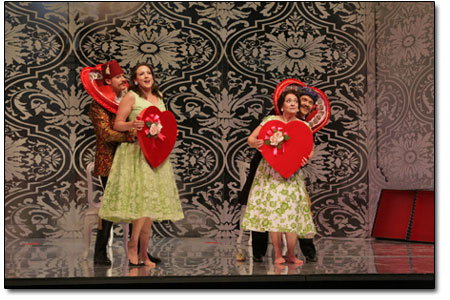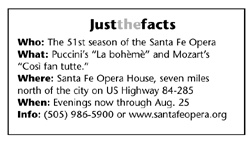| ||||
When Mimi met Rodolfo
by Judith Reynolds In “La bohème,” falling in love takes a Paris minute. In “Così fan tutte,” breaking up takes three hours. When you see first-rate productions of both operas back to back, who cares how long it takes? That’s the beauty of Santa Fe Opera’s 51st season. Every minute is pure pleasure. In 1896, Giacomo Puccini set the boiling point for operatic Romanticism with “La bohème.” Roughly a century earlier, Mozart shaped the musical essence of the Enlightenment when, in a mere four months, he created “Cosi” and infused it with a clear, buoyant spirit. One is an intense, emotional tragedy, the other a comic opera sparkling with wit and irony. Burgundy wine and dry champagne. If you’ve never seen an opera, see these two, and you will experience a concentrated history of the form. Because of their overall popularity, “La bohème” and “Così” have been scheduled throughout the summer. The Santa Fe season runs through Aug. 25. “La bohème” has always seemed to capture the essence of a moment in history. Based on Henry Murger’s personal account of life as a bohemian artist in Paris, the opera focuses on four young men struggling with art, life and love. Into a male world of easy camaraderie comes Mimi (soprano Jennifer Black), a poor and consumptive seamstress. Rodolfo (Welsh tenor Gwyn Hughes Jones), the poet of the garret fraternity, immediately falls in love. This splendid central pair heads up the young cast in Santa Fe. Hughes Jones immediately establishes a powerful presence as Rodolfo. His enormous voice and superb acting ability express the troubled depth of Rodolfo’s passion. In command of all the high passages, Hughes Jones also sustains his long crescendos, returning to a barely audible whisper. Black’s Mimi is both tender and tentative. Puccini’s music underscores their instant attraction, but it’s a mismatch from the start. After the famously beautiful duet, the lovers’ destiny spectacularly tumbles downhill. Musetta (Nicole Cabell) is a captivating spitfire who contrasts with Mimi’s innocence. She toys with men and seeks a life of adventure. Musetta and her off-and-on partner, Marcello (Corey McKern), ignite a counter argument for hooking up. In a split-stage scene, one pair battles while the other doggedly stumbles forward. Musically complex, the scene has clarity due to Director Paul Curran’s staging, and the plot drives mercilessly in a straight line to the final scene back in a garret where it all began. As if it were an open book, the set has leaves. Splayed apart to reveal broken chairs, an old stove, and a skylight, the disheveled apartment fans out, full of debris – papers, paintings, drawings. Set designer Kevin Knight provides enough detail to give the production a just enough of a sense of realism. In Act II, when the artists leave to meet at a nearby café, the leaves of the garret fold up and become a Parisian street. Stage hands string lights and set up café tables as the music proceeds. Such a cinematic treatment mirrors the flow of the music and is a big reason why the production swims by in only 2½ hours including intermission. In contrast, “Così” has a more static design and leisurely takes a full three hours to tell the story of love declared, tested and found wanting. From the beginning, Director James Robinson establishes a comic tone. At rise, young soldiers line up across the full stage in their underwear for medical inspection. While passing muster, two of the young men engage the “doctor,” Don Alfonso (Dale Travis), in conversation about their girlfriends in particular, women’s fidelity in general. Alfonso proposes a wager to prove women are fickle: the scheme that drives the opera. Such dramatic lightness demands a set full of filigree. Designer Allen Moyer has crafted a silver spice box, a set-within-a-set of mirrored floors and shiny patterned walls. When devotion and loyalty begin to disappear, the set splits open. Singers have to maneuver around new obstacles – a nice bit of symbolic design and staging. Inside the white-and-silver box, costume designer David Woolard contrasts choristers and principals in simple colors. The time period is roughly modern; soldiers wear BVDs and toy uniforms, the women skip around in ’50s dresses, and everybody else owns a plain, gray, contemporary suit. When the deception really heats up, the women’s palette shifts to turquoise and orange. Red enters when the disguised lovers proffer huge heart-shaped candy boxes. The boxes quickly become comic weapons. It’s that kind of detail that Santa Fe exploits with style. When Santa Fe Opera recreates the standards, expect to be surprised. The 51st season doesn’t disappoint. •
|



